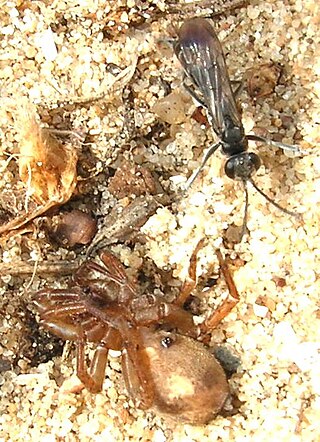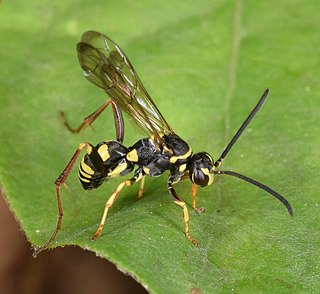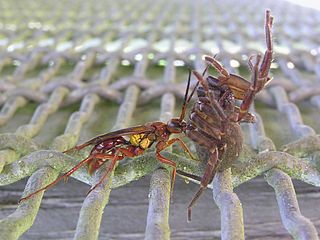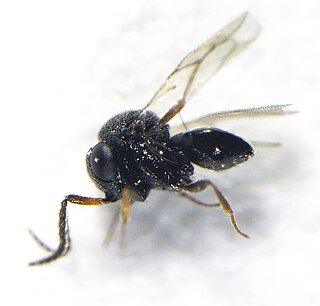
A tarantula hawk is a spider wasp (Pompilidae) that preys on tarantulas. Tarantula hawks belong to any of the many species in the genera Pepsis and Hemipepsis. They are one of the largest parasitoid wasps, using their sting to paralyze their prey before dragging it to a brood nest as living food; a single egg is laid on the prey, hatching to a larva which eats the still-living host. They are found on all continents other than Europe and Antarctica.

Wasps in the family Pompilidae are commonly called spider wasps, spider-hunting wasps, or pompilid wasps. The family is cosmopolitan, with some 5,000 species in six subfamilies. Nearly all species are solitary, and most capture and paralyze prey, though members of the subfamily Ceropalinae are kleptoparasites of other pompilids, or ectoparasitoids of living spiders.

Parasitoid wasps are a large group of hymenopteran superfamilies, with all but the wood wasps (Orussoidea) being in the wasp-waisted Apocrita. As parasitoids, they lay their eggs on or in the bodies of other arthropods, sooner or later causing the death of these hosts. Different species specialise in hosts from different insect orders, most often Lepidoptera, though some select beetles, flies, or bugs; the spider wasps (Pompilidae) exclusively attack spiders.

A wasp is any insect of the narrow-waisted suborder Apocrita of the order Hymenoptera which is neither a bee nor an ant; this excludes the broad-waisted sawflies (Symphyta), which look somewhat like wasps, but are in a separate suborder. The wasps do not constitute a clade, a complete natural group with a single ancestor, as bees and ants are deeply nested within the wasps, having evolved from wasp ancestors. Wasps that are members of the clade Aculeata can sting their prey.

Episyron rufipes, the red-legged spider wasp, is a red and black or completely black spider-hunting wasp.

Pompilus cinereus, the leaden spider wasp is the most widespread species of the Pompilus spider wasps, and throughout a large proportion of its wide distribution is the only species of Pompilus. It is the type species of the genus Pompilus and therefore of the family Pompilidae.

Ceropales maculata is a kleptoparasitic spider wasp found in the holoarctic region.
Epipompilus is a genus of spider wasps in the subfamily Pepsinae, part of the widespread family Pompilidae. Representatives of Epipompilus can be found in Australasia and North and South America. This distribution may indicate that Epipompilus evolved in Gondwana and is similar to other Gondwanan taxa such as the southern beech Nothofagus and Auracaria.

Priocnemis monachus is a species of spider wasp endemic to New Zealand, where it is known as the black hunting wasp or ngaro wīwī. It hunts large tunnelweb or trapdoor spiders, paralysing them with its sting and storing them in burrows for its larvae to eat alive. It is the largest member of the family Pompilidae in New Zealand.

Cryptocheilus australis, the golden spider wasp, is an Australian pepsid spider wasp that was accidentally introduced to New Zealand around 1960.

Sphictostethus nitidus, the golden hunter wasp or red spider wasp, is a species of pepsid spider wasp endemic to New Zealand.
Evagetes crassicornis is a kleptoparasitic spider wasp with a holarctic distribution.

Socca pustulosa is a Orb-weaver spider species in the family Araneidae, and it was first described by a French scientist Charles Athanase Walckenaer in 1841 from Tasmania, Australia, but later on when Walckenaer examined the specimen collected from New Zealand and renamed it as a different species- Epeira verrucosa. Until 1917, Dalmas reviewed the Australian pustulosa and New Zealand verrucosa and realized they were the same species. Although S. pustulosa has been accepted for some time in the genus of Eriophora, the evidence supporting its placement within this genus were not fully convincing. Therefore, an alternative view was proposed in 2022- a new genus established to accommodate pustulosa along with 11 other spider species from Australia; the diagnostic test based on haplotype analysis and systematic morphology study by arachnologists and found the anatomical features of male pedipalp terminal apophysis differs from other orb-web species.

Hemipepsis ustulata is a species of tarantula hawk wasp native to the Southwestern United States. Tarantula hawks are a large, conspicuous family of long-legged wasps that prey on tarantulas. They use their long legs to grapple with their prey before paralyzing them with a powerful sting. Their stings are ranked as some of the most painful in the insect world according to the Schmidt sting pain index. They are solitary, displaying lekking territorial behavior in their mating rituals.

Pepsis grossa is a very large species of pepsine spider wasp from the southern part of North America, south to northern South America. It preys on tarantula spiders, giving rise to the name tarantula hawk for the wasps in the genus Pepsis and the related Hemipepsis. Only the females hunt, so only they are capable of delivering a sting, which is considered the second most painful of any insect sting; scoring 4.0 on the Schmidt sting pain index compared to the bullet ant's 4.0+. It is the state insect of New Mexico. The colour morphs are the xanthic orange-winged form and the melanic black winged form. In northern South America, a third form, known as "lygamorphic", has a dark base to the wings which have dark amber median patches and a pale tip.

Pison spinolae, commonly known as mason wasp, is a solitary wasp of the family Crabronidae, found throughout New Zealand.

Allochares azureus is a species of spider wasp from the family Pompilidae, it is the only member of the monotypic genus Allochares. It occurs in the southern part of North America and is a specialist parasitoid of the Southern house spider.

Zatypota percontatoria is a species of parasitoid wasps that is part of the order Hymenoptera and the family Ichneumonidae responsible for parasitizing arachnids, specifically those of the family Theridiidae.

Trissolcus oenone is a parasitoid wasp in the family Platygastridae, native to Australia and New Zealand. It parasitises the eggs of stink bugs (Pentatomidae), but little is known about its biology.

Ceropales bipunctata, the Two-Speckled Cuckoo Spider Wasp, is a species of diurnal, kleptoparasitic spider wasp in the family Pompilidae. It is an obligate kleptoparasite, meaning that it must rely on the captured provisions of other spider wasps and cannot capture its own. It is found on the Atlantic Coast of North America, north to New Brunswick, Canada. It feeds on nectar primarily from goldenrods, and also other common nectaring plants. It is known to lay an egg on the prey of other pompilids, including the two species Anoplius cleora and Anoplius aethiops. Eggs are laid in the book lung of the spider. These wasps also sometimes lay an egg on prey from spider-hunting wasps in the family Sphecidae.


















